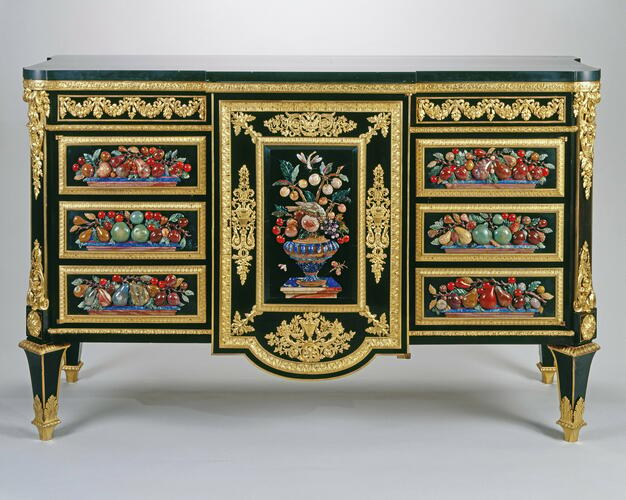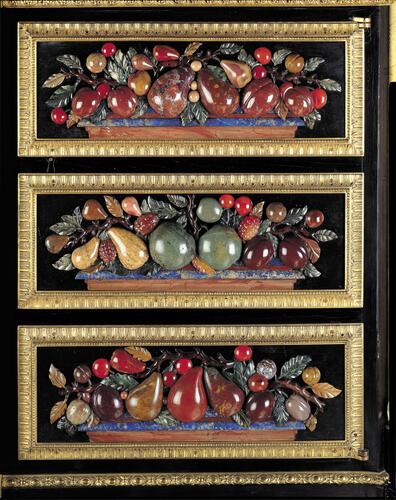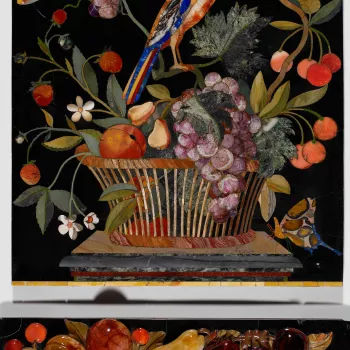Commode (commode à vantaux) 1778
Oak, ebony, pietra dura, gilt bronze, marble | 94.8 x 152.2 x 58.3 cm (whole object) | RCIN 2588
-
Rectangular breakfronted cabinet veneered with ebony, mounted with plaques of pietra dura fruit and decorated with chased gilt-bronze mounts. Black marble top. Central vertical door with segmental apron, flanked by two doors and drawers above; central door has pietra dura vase of flowers and fruit with insects. On tapered, square baluster legs.
Above all else this cabinet is a vehicle for the display of the pietra dura panels that adorn the front and sides. The ostentatious massing of these panels, seven carved in relief with fruit on the front and six inlaid panels at either end, consciously evokes the luxury and splendour of the grand siècle, as do the unusually densely modelled gilt bronze mounts. The panels themselves almost certainly come from one of the great cabinets made for Louis XIV in the royal workshops at the Gobelins; during conservation, two of the relief panels were found to be signed on the back Gachetti [sic], for Gian Ambrogio Giachetti, a Florentine lapidary working at the Gobelins between 1670 and 1675.
Most of these royal cabinets were broken up in the eighteenth century as they went out of fashion, but the pietra dura panels were preserved as precious objects in their own right. With the revival of interest in the Louis XIV period during the 1760s and 1770s, these panels began to be recycled on neo-classical furniture. Among the marchands-merciers (dealer-decorators) who specialised in this field were P.-F. Julliot and Dominique Daguerre. It was almost certainly the latter who commissioned this ambitious piece from Martin Carlin, one of a group of cabinet-makers who worked more or less exclusively for Daguerre.
The first owner of this cabinet was the notorious Parisian opera singer Marie-Joséphine Laguerre (1754-82), whose dissolute life led her to an early grave. It appeared in the sale of her collection, among other furniture by Carlin and Weisweiler. Subsequently it belonged to Baron de Besenval, Colonel of the Swiss Guards and friend of Marie-Antoinette, at whose sale in 1795 Daguerre's connection with its manufacture was first noted.
George IV, whose liking for pietra dura was almost as marked and long lived as his love of Sèvres porcelain, acquired the cabinet in Paris in 1828 through his confectioner François Benois. It may first have been placed in the King's temporary apartments in St James's Palace, but was intended eventually for the rebuilt Buckingham Palace.
Stamped four times M. CARLIN JME
Catalogue entry from Royal Treasures, A Golden Jubilee Celebration, London 2002Provenance
Probably made for Marie-Josephine Laguerre, c.1778; her sale Paris; Baron de Besenval sale, 1795; J.-J.-P.-A. Lapeyrière sale, Paris, 1825; bought in Paris for George IV, May 1828 (£375) by François Benois (Jutsham II, p.251). Repaired by J. Taylor in April 1839.
-
Creator(s)
(cabinet maker)(nationality)Acquirer(s)
-
Medium and techniques
Oak, ebony, pietra dura, gilt bronze, marble
Measurements
94.8 x 152.2 x 58.3 cm (whole object)
Category











